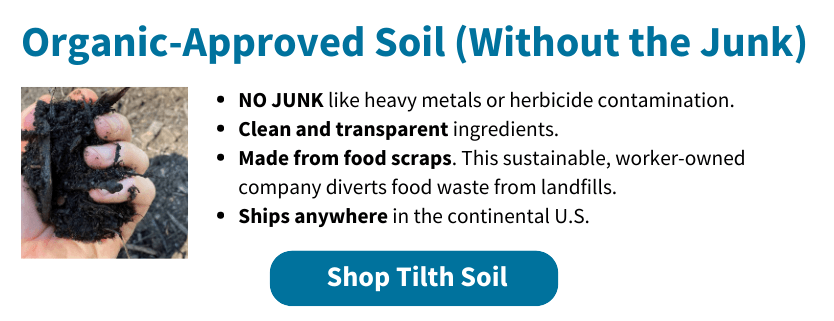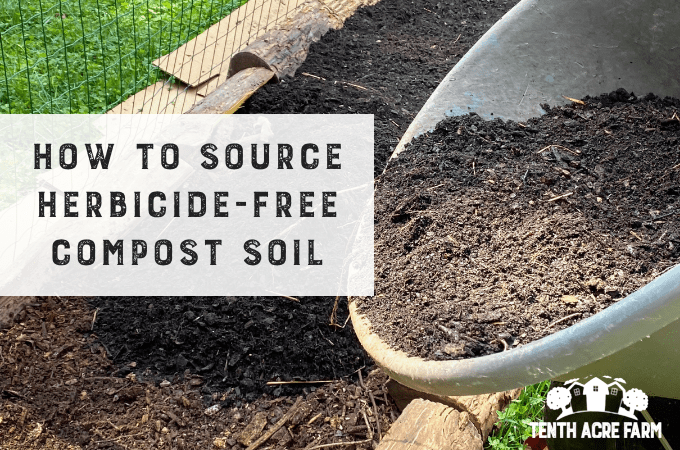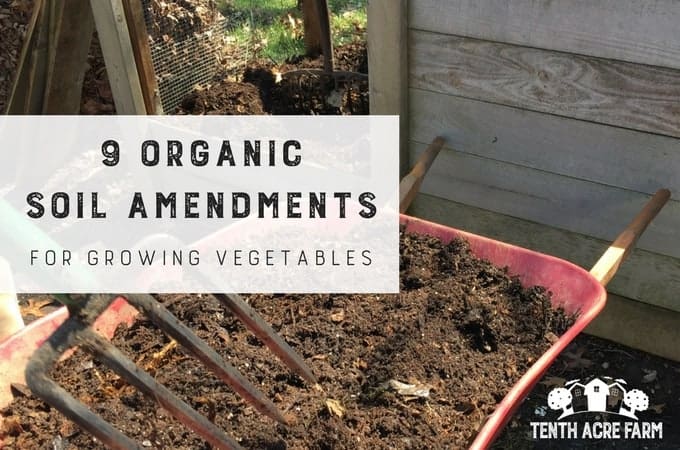Compost is an important component of organic gardens, but nowadays it can easily be contaminated with persistent herbicides, which may damage crops and poison soil. Learn what’s causing the contamination and how to keep it out of your compost bin even if you garden organically and don’t spray.

This page may contain affiliate links. Please read my disclosure for more info.
What are persistent herbicides?
There are four known persistent herbicides: Picloram (Dow AgroSciences, 1957), Clopyralid (Dow AgroSciences, 1987), Aminopyralid (Dow AgroSciences, 2005), and Aminocyclopyrachlor (DuPont, 2010).
These chemicals, which can persist on vegetation, soil, and compost for months or even years, are the main ingredient in over 150 retail products available to homeowners, farmers, and professionals for use in hayfields, horse pastures, as well as on golf courses, roadways, grain crops, and lawns, to kill unwanted broadleaf weeds.
However, the chemicals can be difficult to spot in products, appearing on labels with a variety of spellings.
While persistent herbicides have been around since 1957, their presence in home gardens has ramped up in recent years with better marketing and more availability. Herbicide-contaminated organic matter and compost has been referred to as “Killer Compost”.
How do persistent herbicides get into your compost bin?
According to North Carolina State Extension experts, persistent herbicide contamination is most prevalent in hay, manure, straw, and grass clippings—organic materials that are commonly used to make compost.
*If you buy bulk compost soil or bagged soil products, avoid herbicide contamination by asking the producer these 5 questions before purchasing their product. Even soils approved for organic agriculture are not tested for herbicide contamination!

Persistent herbicide contamination is prevalent in organic materials that are commonly added to a compost bin.
Because of this, persistent herbicides have made their way into the very fabric of our food-producing gardens and farms. This contamination can cause stunted growth and lackluster performance in young perennial crops, annual vegetable crops, and flowers.
Studies show that complete deactivation and breakdown of the contaminant can take up to three or more years.
As a dedicated organic gardener who has suffered the effects of herbicides in my garden from contaminated organic matter, I feel that this is a major breach of environmental stewardship and our most basic right to a clean environment.
And of course, no action exists in a vacuum. In a study of 1300 honeybee hives, for example, up to 31 pesticides were found in a single pollen sample. (“Pesticides” is a broad term that encompasses all -icides, including insecticides, fungicides, herbicides, and more.)
In my ideal world, the agrochemical companies would take their harmful products off the market and pick up the tab for remediating our environment and health.
Instead, they publish stewardship documents with cheerful colors and simple diagrams that entrust farmers, homeowners, and professionals to apply the chemicals appropriately and keep affected materials out of compost and agricultural production. To say this strategy isn’t working is an understatement.

While some herbicides readily break down in compost, persistent herbicides do not.
Would you like to grow more food with less effort? Check out my mini guide, The Permaculture Inspired Vegetable Garden.
Don’t persistent herbicides break down in the composting process?
A common misconception about persistent herbicides is that they break down during the composting process, either due to the high temperature, the microorganisms that are involved in the process, or both.
An herbicide’s chemical structure dictates how it will degrade.
In a cold or passive backyard compost bin, where organic materials are added intermittently, it rarely heats up above 90° F, which is not hot enough to degrade persistent herbicides. In fact, persistent herbicides often don’t biodegrade even in a commercial composting facility, where the temperature reaches up to 170° F.
What’s more, while microorganisms help some herbicides to rapidly decompose in composting, they can exacerbate the problem with regard to persistent herbicides. Rather than helping them to break down, microorganisms may cause them to concentrate in the finished compost.
The US Composting Council explains why persistent herbicides tend to concentrate in animal manure and compost:
Composting is digestion by microorganisms. Microorganisms are animals. Scientific studies show that persistent herbicides pass unaltered during animal digestion. In fact, animal digestion tends to concentrate these chemicals.
[That’s because] persistent herbicides break down much more slowly than the materials in compost, and therefore, most of the chemicals pass into the finished compost.”
To summarize the problem, free organic materials collected offsite may be contaminated with herbicides and pass on that contamination to your compost or garden soil. The herbicide may also become concentrated through the composting process.
Wondering if you have herbicide-contaminated crops or soil?
Herbicide-affected plants can present various symptoms, including leaf curling, distorted shoot tips, stunted growth, misshapen fruit, reduced yields, and more. See pictures of damaged crops in my article about the effects of persistent herbicide in manure.
The green bean herbicide test, also called a bioassay, uses legume crops such as beans, peas, or clover as a sort of canary in the coal mine. This test, which is easy for home gardeners to conduct, utilizes these herbicide-sensitive crops to analyze finished compost, manure, or bagged soils before you add it to your garden.

Pea seedlings can be used in a bioassay test to determine herbicide contamination in compost, manure, and bagged soils.
If you determine that you have contaminated organic matter, report your findings to your local extension office and to the source of the material, if known. Don’t put herbicide-contaminated compost in your garden. Furthermore, do not eat produce from plants showing damage.
How to Rehabilitate Herbicide-Contaminated Compost or Garden Soil
In time, persistent herbicides eventually break down, but not on a time scale that organic gardeners would appreciate. However, with some patience and special care, you can nudge the contaminants toward a speedier decomposition process.
Here are some strategies that can speed up the process:
- Distribute activated charcoal or biochar throughout the compost bin or contaminated area to neutralize the chemical while it gradually breaks down. This can help to reduce runoff of the contaminant.
- Spread the compost over a small area and plant it with a cover crop of annual grasses. Grasses aren’t sensitive to these herbicides that target broadleaf plants, and can help absorb and bind to the chemical. I prefer to sow a mix of foxtail millet and sorghum sudangrass. At the end of the season, cut and discard the plant matter in the trash.
- Higher heat and oxygen can speed up the decomposition of these contaminants. While I typically promote no-till garden practices, tilling several times during the hottest months of the year solarizes and oxygenates the soil. Again, spread the compost over a small area in order to till it.
Whichever rehabilitation strategy you use, conduct the bioassay method to test regularly. Then repeat your preferred rehabilitation until the compost tests clean.
Tips for Making Herbicide-Free Compost
Building and maintaining a no-till, organic garden takes a lot of organic materials and compost. Sourcing herbicide-free materials for making clean compost and mulch takes special consideration, but it can be done.
The following are some ideas for avoiding or reducing herbicide contamination when sourcing materials for your compost.

Manure is a common source of herbicide contamination in the garden and compost bin.
Farm Inputs
Hay, manure, and straw are some of the best organic materials for creating great compost, and also some of the most likely to contain persistent herbicides.
Can you develop these materials organically on your own site? It would mean not spraying hay or straw fields. With regard to livestock, use certified Organic feed, and use no-spray materials for bedding.
Not enough space to grow your own farm inputs? Search your area for No Spray or certified Organic farmers. I drive an hour and a half to get to an Organic farmer who sells herbicide-free hay, manure, and straw. Know your farmer and ask lots of questions.
Food Waste
Food waste is far less likely than manure, straw, hay, and grass clippings to contain persistent herbicides. So get started with fruit and vegetable scraps from your own kitchen. Are there other sources of food waste in your community that you can incorporate into your compost bin?
Create your own “manure” by starting a DIY worm bin for turning food scraps into nutrient-rich worm castings.
Yard Waste
You’re not spraying herbicides on your lawn, right? Good, then you’ve got grass clippings, leaves, and other yard waste!
Picking up bags of leaves and yard waste from the curb used to be a great way to gather free, surplus organic materials from around your neighborhood. However, herbicides have become common in residential landscapes.
While farmers and professionals are trained and certified by the federal EPA to properly apply herbicides, homeowners are not. I believe there is a lot of misuse and overuse of herbicides in residential neighborhoods because of it.
If you’re picking up free yard waste bags, here’s how I would think about it:
Fall leaves are an incredibly rich source of nutrients, and they break down to become an amazing mulch and soil conditioner. And it’s unlikely that ornamental trees have been sprayed with herbicides. So, grab those leaf bags!
However, skip the miscellaneous yard waste bags containing assorted grass clippings and weeds, since they have a higher chance of being contaminated. Connect with your family, friends, and neighbors who for sure don’t spray!
Coffee Grounds
I used to recommend picking up coffee grounds from local coffee shops. I’ve done this often. But coffee is one of the most intensively sprayed crops with pesticides. Interestingly, the EPA classifies herbicides as pesticides.
Does the pesticide residue make it into the cup and then remain in the coffee grounds? There’s been no testing to prove or disprove this hypothesis.
Moral of the story: Use your own (certified Organic) coffee grounds and seek out those local coffee shops that source responsibly grown coffee.
Growing Your Own Organic Compost Materials
If you’re accustomed to making compost using a surplus of inputs from local farms as well as local yard waste, then you might be wondering how to collect enough bulk materials that are herbicide-free.
The good news is that by changing a few everyday gardening practices, you can grow your own materials for roughly the same amount of time it takes to collect these materials from around your community.
Having a diversity of plantings in your own garden is a key component of a resilient permaculture garden, which makes use of resources within the system.

A clover lawn creates a nitrogen-rich “green manure” for the compost bin.
Learn more about improving the quality of your soil in your permaculture garden:
You’ll find loads of information just like this in my award-winning book, The Suburban Micro-Farm.
Green Materials for the Compost Bin
“Biomass” plants like borage, comfrey, and rhubarb make oodles of green matter that can be chopped regularly and added to the compost bin. I chop my comfrey plants back about once a week throughout the growing season.
Here’s a unique idea that I tried in my new yard: Grow a clover lawn as a green manure.
Seriously, try mowing a clover lawn in the spring or summer and piling up the clippings. The high-nitrogen material will heat up quickly and smell exactly like manure! (Ask me how I know!) To avoid bad smells, practice good composting by layering green and brown materials in the compost bin.
You can also grow cover crops in the garden. When you chop them back, the roots enrich the soil while giving you green matter for the compost bin.

When you cut cover crops back, the roots enrich the soil and you get green matter for the compost bin.
Brown Materials for the Compost Bin
One of my favorite ways to make a straw-like mulch and generate a “brown” carbon material for the compost bin is to grow ornamental grasses. They create a lot of organic matter in a relatively small amount of space.
Simply chop ornamental grasses back at the end of the season when the grass stalks have dried, and then into smaller pieces to make mulch and a compost material. Seek out a clumping species/variety that is not invasive in your locale.
Ideally, you’ll have deciduous trees that drop leaves for you to collect.
Alternatively, turn a backyard orchard into a food forest that generates organic material in addition to food, by layering together fruit trees, berry bushes, herbs, flowers, and more. Cut back the undergrowth of the fruit trees to use as a nutrient-rich mulch and compost material.
Finally, you might be able to sneak in a mixed hedgerow along a property line, which can provide deciduous organic matter, undergrowth cuttings, and smaller woody materials from pruning for the compost bin.
In short, you have more control over what goes into your compost by growing your own organic materials. Doing this makes your garden more resilient and less susceptible to outside risks like herbicide contamination.
Can you think of other sources of clean organic compost materials?

Fall leaves from the yard make a perfect “brown” addition to a compost bin.
As we’ve seen, persistent herbicides are becoming more widespread in the organic materials that enrich our compost and gardens. Therefore, starting with clean raw materials is important. However, with effort you can grow and source clean ingredients for your compost bin and maintain a healthy garden ecosystem.
4 FAQs About Herbicides in Compost
#1: How do you test for herbicides in compost?
Herbicide-affected plants can present various symptoms, including leaf curling, distorted shoot tips, stunted growth, misshapen fruit, reduced yields, and more.
A bioassay is a test that uses herbicide-sensitive legume crops, such as beans, peas, or clover, to analyze finished compost soil, manure, or bagged soils before you add it to your garden. It’s a simple test that any home gardener can conduct.
Simply plant some pea or green bean seeds in the questionable compost soil, and care for them under grow lights if necessary. After 14 days check for symptoms of contamination.
#2: How do you get herbicide out of compost and soil?
Persistent herbicides in compost soil eventually break down, but not on a time scale that organic gardeners would appreciate. However, you can nudge the contaminants toward a speedier decomposition process.
Distribute activated charcoal or biochar in the compost to neutralize the contaminant. Or plant the compost with grasses like millet and sorghum, which will bind to the herbicide. Cut and discard at the end of the season.
#3: How do you prevent herbicide from getting in compost?
Persistent herbicide contamination is most prevalent in hay, manure, straw, and grass clippings—organic materials that are commonly used to make compost. Source these materials from no spray, organic farms or grow/raise/mow your own chemical free compost materials.
Food scraps are a great material for the compost bin, as they’re less likely to contain herbicide residue.
#4: Do herbicides break down in compost?
While some herbicides can break down in the composting process, there are a few persistent herbicides that do not biodegrade in composting, and can remain active in the finished compost. This contaminated compost can damage crops and garden soil.
Have you experienced damage from persistent herbicides in your garden or compost bin? If so, how did you handle it?








Natalie says
I’ve learned the hard way that grabbing bags of leaves from the curb can be a problem. Many of my neighbors use a lawn treatment service. When the leaves are raked up some contaminated grass and soil get mixed in. My garden beds were a disaster this year after being bedded down with those leaves. Ugh.
Amy says
So sad. You’re right, those leaf bags may have yard waste mixed in inadvertently or on purpose. It’s not like the bags are labeled, so it’s hard to know what’s inside them! I think I’d stick with only getting them from people you know who for sure don’t spray. :/
John says
I like what you’ve said here, but when you mention “food waste” as a great source for the compost pile…you’re missing something. How can you be so concerned with “persistent herbicides” and ignore the large amount of other pesticides dumped on the crops that supply the “food waste”. The Tilth brand organic soil also emphasizes it’s herbicide free nature but conveniently ignores the pesticide rich “food waste” that probably supplies the larger portion of it’s organic soil. And not to mention the probable GMO quality of the “organic” soil.
Amy says
You’re right, herbicides are everywhere and mostly unavoidable, potentially even if you eat certified Organic foods and compost only certified Organic food waste. However, what I’m focusing on in this article, what producers like Tilth Soil work hard to avoid, and which organizations like the US Composting Council seek to educate about, are PERSISTENT HERBICIDES. As discussed above, this is a different (and newer) class of herbicides that persists through animal digestion and elimination, as well as through most composting processes. Currently the best way to test organic material for persistent herbicides is to run the green bean herbicide test mentioned above, and to avoid those materials that are known to have the highest concentration.
Valeria Vincent Sancisi says
I have to say this is one of the best articles as far as alerting us about what is happening to the soil and giving us the tools to deal with what is now happening world wide.
Jeff Huddle says
My neighbor gave me some semi composted cow manure. He feeds hay that is sprayed. Killed all my peas and tomatoes last year and this year is not looking too good. I am willing to try the charcoal but probably too late this year. I wonder if it could be sprinkled on the soil and watered in. Corn does not care about chemical and does okay. Squash also does okay. Big lesson learned.
Steven R says
QUESTION ???Would c astings that come from Composting worms that lived in a Horse compost windrtow with Herbicide residue ALSo have the herbicide in the castings ??? OR do worms guts destroy the herbicide ? has anybody ever done a test on this ??????
Amy says
Good question, it seems like worm castings could be a candidate for being more concentrated than regular compost, since animal digestion can concentrate the herbicide according to the US Composting Council. However, I’m not aware of any studies specific to worm compost. I’d consider doing the green bean herbicide test that I mention in the above article.
Louise says
35 years ago, newly established in this property (former farm, with much of soil intact), I set up, under a mulberry tree, and out of view of manicured-lawn neighbors, a leaf corral with welded wire and t-posts. Gathered leaf bags to tune of about 100, in our truck. Dumped the leaves into the corral. Next spring(or maybe a year later–the mulberry had appreciated the richness, and sent its roots up into the rotting leaves, such that I could not fork up any leaves because the roots were so entangled with the leaf compost. Didn’t try that trick again. We began to use that space instead for our woodpile–thus soil beneath logs must be doubly rich.
Veronica says
I have three questions that I’m hoping you can answer.
First and second concerning fall leaves, I’ve often wondered if the
systemic chemicals that are used on the trees to kill pests
(especially the Spotted Lantern Fly and the Emerald Ash
Borer) into the leaves and then into our compost piles?
Second, are these chemicals in the flowers of trees in the
spring? I have kept my yard and gardens organic for
twenty years and see less and less bees every year.
The third question is about comfrey. I make comfrey tea
for my garden every year, I read somewhere that I shouldn’t
use the plants that have flowered. Have you heard this?
Do you use them whether they have flowered or not?
Thanks for your time!
Amy says
I’m unsure about the tree treatments and what class of pesticides they’re considered to be. You should ask about the life of these pesticides. Most biodegrade rather quickly and don’t pose a long-term thread. If you’re working with knowledgeable arborists, they’re likely not spraying while trees are in bloom. If they are, then I’d stop that service immediately.
Natali says
Hi, Amy!
Thank you for so informative and valuable site.
I am just about to start small garden bed and I planned to start worms composting, but if I buy ordinary ie non organic veggies this likely means my worm compost will be contaminated with industrial -cides? Could the contamination be neglected or will it significantly affect the soil? I can’t afford buying organic products
Amy says
I wouldn’t worry about pesticides from your food harming the worms. However, you might avoid composting the Dirty Dozen— the fruits and vegetables containing the highest amount of pesticide residue.